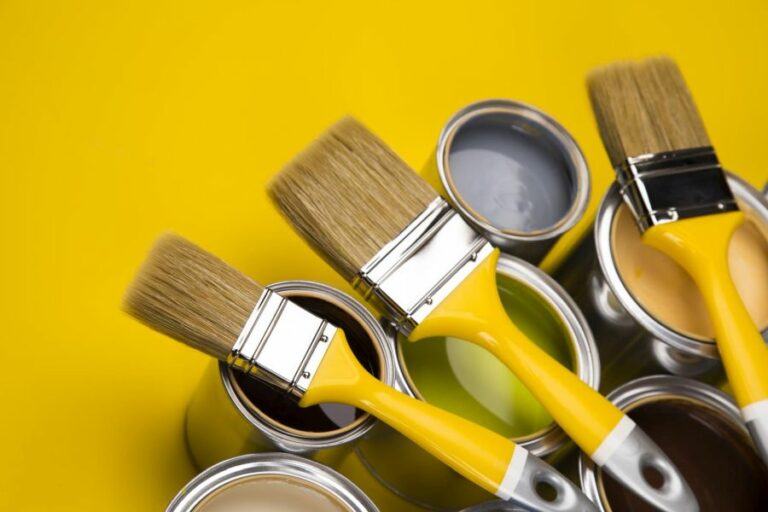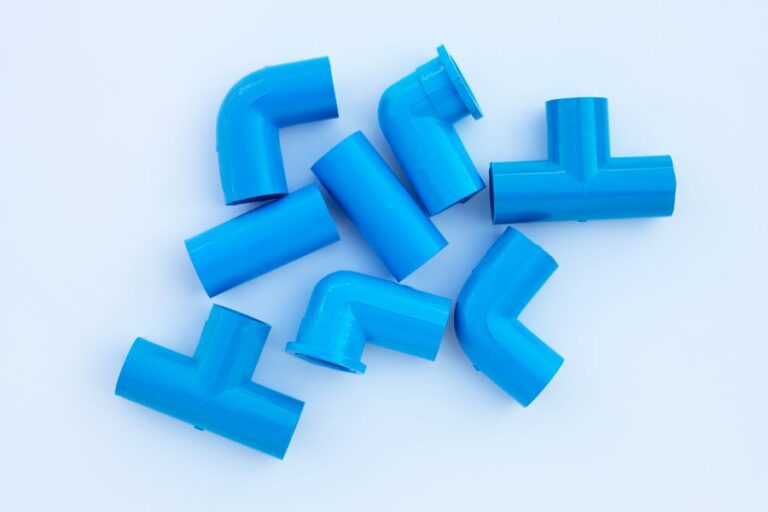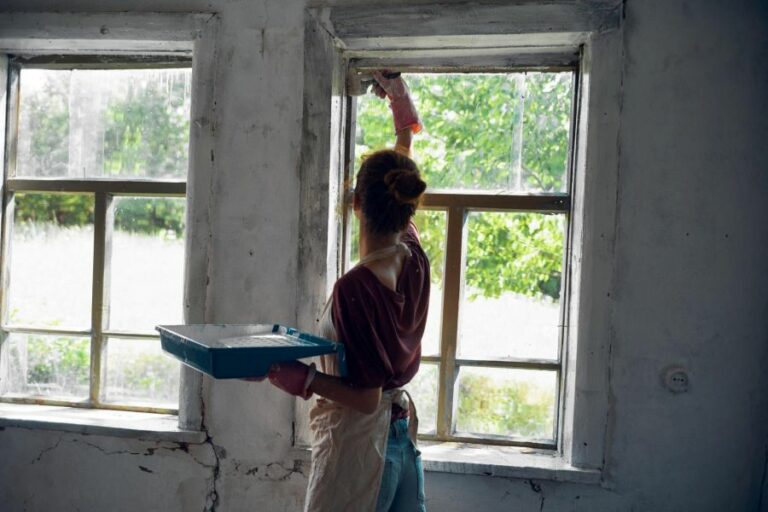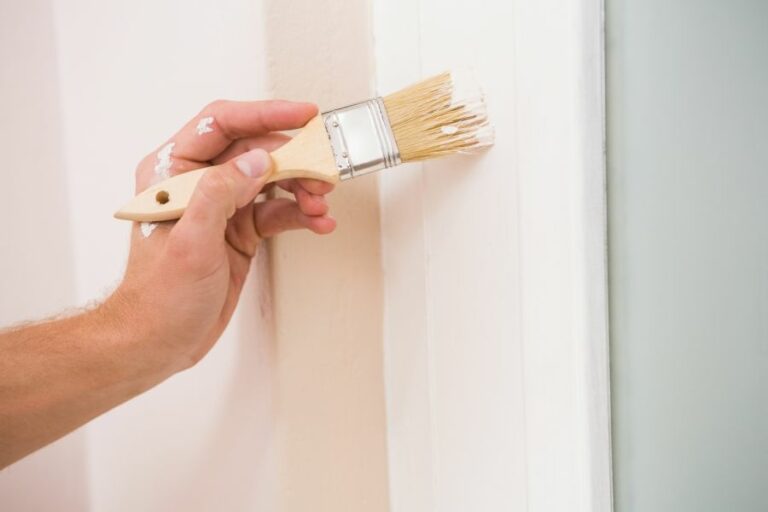What Paint To Use For Outdoor Wood. What Pros Say
Choosing the right paint for outdoor wood projects can be daunting, especially with the vast array of available options. Fret not, though! We are here to help you make the most informed decision and protect your wooden surfaces for years. So, let’s dive in and explore the world of outdoor wood paint options and discover which one will suit your needs best.
What paint to use for outdoor wood:
For outdoor wood surfaces, acrylic latex paint is a versatile and durable option, ideal for surfaces like sidings, fences, and furniture. Oil-based paint suits surfaces needing additional protection and a classic finish, such as door and window trims or wooden decks. Prepping the wood surface and choosing exterior-specific products will ensure optimal results.

Discover the perfect paint for your outdoor wood projects! Dive deeper into the world of exterior wood paints, including factors to consider, top choices, and expert tips for durability and aesthetics. Read on to find the ideal paint to transform, protect, and beautify your outdoor wood surfaces.
Contents
- 1 Selecting the Appropriate Paint for Outdoor Wooden Surfaces
- 2 Determining the Most Suitable Paint for Exterior Wood Surfaces
- 3 Is It Possible to Use Any Type of Paint on Exterior Wooden Surfaces?
- 4 What is the process for painting exterior wooden surfaces?
- 5 What Type of Paint is Suitable for Outdoor Use?
Selecting the Appropriate Paint for Outdoor Wooden Surfaces
Selecting the right paint for outdoor wood is crucial for the longevity and appearance of your wooden surfaces.
• Acrylic Latex Paint: A Versatile Choice
Acrylic latex paint is a popular choice for outdoor wood surfaces due to its durability, low odor, and ease of cleanup. This type of paint is water-based and uses acrylic as a binder, which provides excellent adhesion to wood and enhanced resistance to weathering.
One of the main advantages of acrylic latex paint is its versatility. It can be used on various surfaces, including wooden sidings, fences, and furniture. Moreover, this paint is available in a wide range of colors and finishes, making it a suitable option for both functional and decorative purposes.
When selecting an acrylic latex paint for outdoor wood, looking for products labeled as “exterior” or “for outdoor use” for optimal results is essential. This paint category often contains additives that help resist mildew, fading, cracking, and peeling, ensuring your wooden surfaces remain in excellent condition.
– Recommendation: Top-Quality Acrylic Latex Paint
As an experienced painter, I recommend using top-quality acrylic latex paint for outdoor wood projects. High-quality paints usually have higher acrylic binders, making them more durable and weather-resistant. Behr Premium Plus Exterior is an example of a top-rated exterior acrylic latex paint.
• Oil-Based Paint: A Classic Option
Oil-based paint is a more traditional choice for outdoor wood projects. It consists of resins and solvents and is known for its excellent adhesion properties and lustrous finish. Due to its slow drying time, oil-based paint allows for better penetration into the wood surface, providing a durable, long-lasting finish.
This type of paint is ideal for high-traffic areas and surfaces that require additional protection, such as door and window trims or wooden decks. However, it may not be as environmentally friendly or easy to clean as acrylic latex paint.
Before choosing an oil-based paint for your outdoor wood project, keep in mind that this type of paint produces strong odors and may require longer drying times. You should also use a compatible primer to enhance the paint’s adhesion and durability further.
– Recommendation: High-Quality Oil-Based Paint
Considering its durability and classic finish, a high-quality oil-based paint can be a suitable option for specific outdoor wood projects. A top-rated example is the Benjamin Moore Arborcoat, an oil-based exterior wood stain that offers excellent protection against the elements.
• Paint or Stain: Understanding the Difference
When considering which product to use for your outdoor wood projects, it’s essential to understand the differences between paint and stain. Stains are designed to penetrate the wood surface, offering protection while enhancing the natural appearance of the wood grain.
Paint, on the other hand, forms a protective barrier on the wood surface, providing comprehensive protection against the elements.
Both paint and stain have their advantages and can be the right choice, depending on the desired aesthetic and protective needs of your project. If you wish to preserve the natural beauty of the wood, opt for a stain.
If increased durability and a more significant color transformation are desired, consider using paint.
• Prepping Your Outdoor Wood for Painting
To maximize the durability and appearance of your outdoor wood paint, proper surface preparation is essential. Before painting, ensure that the wood surface is clean, dry, and free of any loose paint, dirt, or debris.
Using a wire brush or a paint scraper, remove any peeling or flaking paint. For optimal adhesion, it is crucial to sand and prime the wood surface, especially when using oil-based paint, as recommended by the United States Department of Agriculture (USDA).
• Final Thoughts
In summary, acrylic latex paint is a versatile and durable option for outdoor wood projects, while oil-based paint is ideal for surfaces requiring additional protection and a classic finish.
Consider your project’s specific requirements and desired aesthetic when choosing the right paint for your outdoor wood. Don’t forget to allocate time for adequate surface preparation to ensure a long-lasting, impeccable finish.
Determining the Most Suitable Paint for Exterior Wood Surfaces
Choosing the right paint for exterior wood surfaces is a critical decision that can greatly impact your wood structures’ durability, aesthetics, and overall protection.
• Understanding Paint Types and Their Benefits
To determine the most appropriate paint for your exterior wood, it’s important to first understand the different types of paint available, their benefits, and their limitations.
– Acrylic Latex
Acrylic latex paint is one of the most popular options for exterior wood surfaces. It offers excellent adhesion, water resistance, and flexibility, which are essential for ensuring your wood structures remain protected against harsh weather conditions.
Some key benefits of acrylic latex paint include:
- Long-lasting protection and durability
- The fast drying time of 1-2 hours
- Easy application and cleanup with soap and water
- Resistance to mildew, cracking, and chipping
Despite its many advantages, acrylic latex paint is not always the best choice for certain exterior wood types or browsing conditions. For example, it may struggle to adhere to oily, resinous woods like cedar or redwood, which may require a primer or alternative paint solution.
– Oil-Based Paint
Oil-based paint, also known as alkyd or solvent-based paint, has been used for many years on exterior wood surfaces. It provides a tough, flexible finish that can withstand extreme temperatures and wear, making it a popular choice for painting wood surfaces exposed to harsh outdoor elements.
Key benefits of oil-based paint include:
- Excellent durability and resistance to damage
- Smoother, self-leveling finish
- Superior penetration and adhesion on various wood types
- The extended lifespan of up to 10 years
However, there are some downsides to using oil-based paint:
- Longer drying time (sometimes up to 24 hours)
- The release of volatile organic compounds (VOCs), with strong odors
- Requires the use of paint thinners and mineral spirits for cleanup
Additionally, it’s worth noting that oil-based paints are becoming less popular due to environmental concerns and stricter regulations on VOC emissions.
– Paint-and-Primer-in-One
Recent advancements in paint technology have led to the development of paint-and-primer-in-one products. These all-in-one solutions streamline the painting process, saving both time and effort by eliminating the need for a separate primer application.
Benefits of paint-and-primer-in-one include:
- Time and labor savings
- Improved adhesion and durability
- Suitable for most exterior wood surfaces
However, paint-and-primer-in-one may not always be the ideal solution for all exterior wood surfaces, particularly on wood with high moisture content or severe weathering. In such cases, a dedicated primer and paint combination may offer better results and protection.
• Paint Sheen and Its Impact on Exterior Wood
Another crucial consideration when selecting paint for wood surfaces is the paint sheen or gloss level. Paint sheens range from flat/matte to high-gloss, with varying degrees of shine in-between. The sheen you choose can affect the appearance, durability, and maintenance of your exterior wood surface.
– Flat/Matte
Flat or matte paint offers little to no shine, which can help conceal minor imperfections and achieve a uniform appearance on wood surfaces. However, this type of sheen may be more prone to staining and dirt retention.
– Satin
Satin paint has a soft, velvety sheen that offers a balance of both aesthetics and durability. It’s ideal for wood surfaces such as siding or trim, as it provides adequate protection against weathering, chipping, and moisture.
– Semi-Gloss
Semi-gloss paint offers a higher level of shine and increased durability, making it an excellent choice for areas exposed to high levels of moisture or frequent cleaning, such as doors or windowsills.
– High-Gloss
High-gloss paint has the highest level of shine and provides superior resistance to dirt, moisture, and wear. It is often used for accentuating decorative wood elements, such as front doors or shutters, but may accentuate surface imperfections.
• How to Choose the Best Paint for Your Exterior Wood
When selecting the best paint for your exterior wood surface, consider the following factors:
- Type of wood: Different wood types may require specific types of paint or additional primer for optimal adhesion and protection. For example, tannin-rich woods like cedar or redwood may benefit from an oil-based paint or a dedicated primer to prevent tannin bleed.
- Weather conditions: Consider your local climate when choosing your paint, as extremely hot or cold temperatures can affect paint performance. High-quality acrylic latex paint is often recommended for its flexibility and ability to withstand fluctuating temperatures.
- Accessibility for maintenance: Choose a paint that matches the level of upkeep you’re willing to commit to. Higher-gloss sheens may require more frequent cleaning or touch-ups to maintain their appearance.
- Aesthetic preferences: Your taste in color, sheen, and style should guide your decision while keeping in mind the impact of the chosen paint on your wood’s durability and protection.
• Final Thoughts
In conclusion, the best paint for exterior wood surfaces largely depends on the specific needs and conditions of your project. Acrylic latex paint, oil-based paint, and paint-and-primer-in-one all have their advantages and drawbacks, as do the various paint sheens available.
By carefully evaluating your wood type, weather conditions, maintenance preferences, and aesthetic desires, you can select the most appropriate paint to ensure long-lasting protection and beauty for your exterior wood surfaces.
Paint Type | Pros | Cons |
|---|---|---|
Acrylic Latex | – Excellent adhesion – Durable and long-lasting – Low odor and low VOC – Easy to clean up with water | – May not adhere well to bare wood without primer – Not as flexible as oil-based paints |
Oil-Based | – Superior adhesion to wood – Penetrates wood fibers for added protection – Flexible and resistant to cracking | – Higher odor and VOC content – Longer drying time – More difficult clean up (requires mineral spirits) |
Water-Based Alkyd | – Combines benefits of acrylic and oil-based paints – Excellent adhesion and durability – Low odor and low VOC – Easy to clean up with water | – May require primer for bare wood – Can be more expensive than other options |
Is It Possible to Use Any Type of Paint on Exterior Wooden Surfaces?
Painting outdoor wood surfaces can provide protection and aesthetics to the exterior of your home or other wooden structures such as decks, sheds, and fences. Selecting the right paint for the job is crucial to ensure the longevity and durability of the finish.
• Choosing the Right Paint for Outdoor Wood
There are multiple factors to consider when selecting paint for your outdoor wood project. The primary considerations are the type of wood, the specific paint formulation, and the unique environmental elements the wood is exposed to.
– Paint Types for Outdoor Wood
There are two main categories of paint suitable for outdoor wood: oil-based (also known as alkyd-based) paints and water-based (acrylic or latex) paints. Each has distinct characteristics that may make it more suitable for a specific project or desired look.
Oil-Based Paints
Oil-based paints have long been a popular choice for exterior woodwork due to their durability, long-lasting finish, and excellent leveling properties. They are highly resistant to water, providing a protective barrier against moisture penetration, which can reduce the potential for wood rot and decay.
Oil-based paints also generally have a glossier finish than water-based paints, which can be more aesthetically pleasing for some.
However, there are some disadvantages to using oil-based paints on outdoor wood. They take longer to dry, produce strong odors, are harder to clean up and release more volatile organic compounds (VOCs), which can negatively impact air quality.
Additionally, oil-based paint may become brittle over time, leading to cracking or peeling.
Water-Based Paints
Water-based paints, such as acrylic or latex, have become increasingly popular for outdoor wood applications in recent years due to their lower VOC emissions, easy water clean-up, and faster drying times.
Modern acrylic formulations have been developed to offer excellent durability and resistance to moisture, ultraviolet (UV) radiation, and microbial growth, making them well-suited for outdoor wood applications.
Though still a solid option, latex-based paints can be less durable than acrylic and may be more prone to fading and discoloration over time, especially in areas with high UV exposure.
– Environmental Considerations for Outdoor Wood Paint Selection
The unique environmental conditions your outdoor wood is exposed to should also play a role in selecting the appropriate paint. Climate, sunlight exposure, and potential moisture contact are all factors to consider.
As a general guideline, acrylic-based paints perform exceptionally well in various environments and can withstand harsh weather, UV exposure, and moisture.
In exceptionally damp or humid climates, you may want to consider using a paint with added mildewcides to reduce the likelihood of mold and mildew growth. If your project is subject to significant sunlight exposure, seek a paint that offers an adequate level of UV protection.
• Preparing the Outdoor Wood Surface for Painting
Proper surface preparation is key to a long-lasting, durable finish, regardless of which paint you choose for your outdoor wood project. To prepare the surface, follow these steps:
- Clean the surface: Remove any dirt, dust, or debris using a soft brush, cloth, or sponge. Consider using a mild detergent solution to clean more stubborn dirt, followed by thorough rinsing with water. Allow the wood to dry completely before proceeding.
- Sand the surface: Sand the wood surface with medium-grit sandpaper (80-120 grit) to smooth out any rough spots and remove old paint or finish. Be sure to sand in the direction of the wood grain to avoid scratching the surface.
- Fill any gaps or cracks: Use a high-quality exterior wood filler to fill any gaps, cracks, or holes in the wood. Once the filler has dried, sand the area smooth.
- Apply a primer: A high-quality exterior wood primer will help the paint adhere better and provide additional protection against moisture and UV damage. If you are using water-based paint, make sure to choose a water-based primer. Similarly, if using an oil-based paint, opt for an oil-based primer.
• Painting the Outdoor Wood
After preparing the surface, follow these steps to apply the chosen paint to the outdoor wood:
- Stir the paint well and pour it into a paint tray.
- Using a high-quality brush or roller, apply a thin, even coat of paint to the entire wood surface. Be sure to follow the grain of the wood and avoid overloading the brush or roller, which can lead to drips and an uneven finish.
- Allow the paint to dry completely before applying additional coats. Depending on the paint type and environmental conditions, this could take anywhere from 1-24 hours. Refer to the paint manufacturer’s recommendations for specific drying times.
- Repeat steps 2 and 3, applying 2-3 coats of paint for optimal coverage and protection.
Through careful consideration of paint type and preparation techniques, you can achieve an excellent and long-lasting finish on your outdoor wood surfaces.
Whether using oil-based or water-based paints, be sure to follow the manufacturer’s guidance and recommendations for application and maintenance to ensure the optimal performance of your chosen paint product.
Paint Type | Usage on Outdoor Wood? | Benefits |
|---|---|---|
Latex Paint | Yes | Water-resistant, flexible, easy to apply and clean, low VOCs |
Oil-Based Paint | Yes | Durable, excellent adhesion, smooth finish |
Exterior Acrylic Paint | Yes | Water-resistant, UV-resistant, flexible, retains color |
Enamel Paint | Yes | Hard, durable, high-gloss finish, wear-resistant |
Interior Paint (Not specifically designed for outdoor use) | No | Not recommended for outdoor wood, not durable enough for outdoor conditions |
What is the process for painting exterior wooden surfaces?
Painting outdoor wood is an essential task for maintaining the beauty and durability of wooden structures such as fences, decks, and furniture. Properly painting outdoor wood not only enhances its appearance but also protects it from harsh weather conditions, insects, and decay.
• 1. Choose the Right Paint and Tools
The first step in painting outdoor wood is selecting the right paint and tools necessary for the job. There are specific types of paint formulated for use on outdoor wood, known as exterior paint. These paints are designed to withstand harsh weather conditions and provide excellent durability.
- Exterior Paints: Choose a high-quality, 100% acrylic latex exterior paint. This type of paint is water-based and has excellent adhesion, flexibility, and resistance to cracking or peeling. Some exterior paints also include added protection against mold and mildew.
- Primer: A good quality exterior primer is essential for proper adhesion and to provide a smooth surface for the paint. Primers are available in oil-based and latex-based forms, but latex-based primers are easier to clean and provide excellent adhesion for exterior paint.
- Tools: You will need a variety of tools for the job, including brushes, rollers, paint trays, a drop cloth, masking tape, sandpaper (medium and fine grit), a paint scraper, a ladder (if necessary), and protective gear such as gloves and safety glasses.
Note: The US Environmental Protection Agency recommends using a HEPA vacuum and a wet-sanding or wet-sanding sponge, especially when working with lead-based paint.
• 2. Prepare the Wood Surface
Proper surface preparation is critical for achieving a beautiful and long-lasting finish. The wood surface must be clean, dry, and free of any loose, peeling, or flaking paint.
- Clean the Surface: Remove any dirt, debris, and mildew from the wood by scrubbing it with a mixture of warm water and mild detergent. Rinse with clean water and allow the wood to dry completely.
- Scrape and Sand: Use a paint scraper to remove any loose, peeling, or flaking paint. Then, sand the surface with medium-grit sandpaper to smoothen any rough spots and ensure proper adhesion for the primer and paint. Follow up with fine-grit sandpaper for a smooth and even finish. Remember to wear proper protective gear while sanding, such as a mask, gloves, and safety glasses.
- Repair Damaged Areas: Inspect the wood for any signs of damage, such as cracks, holes, or rot. Fill small cracks and holes with an exterior wood filler and sand it smooth once it has dried. Replace any severely damaged or rotted wood before proceeding with painting.
- Remove Dust and Debris: Use a tack cloth or a vacuum to remove any dust and debris from the wood surface before priming.
• 3. Apply Primer
Applying an exterior primer is essential for a smooth and even paint finish. A primer ensures proper adhesion and provides a uniform surface for the paint.
- Mask and Protect Surrounding Areas: Use masking tape to protect windows, doors, and hardware from primer and paint. Lay down a drop cloth to protect the ground or surrounding areas from drips and spills.
- Apply the Primer: Using a brush or roller, apply a thin and even coat of primer on the wood surface. Make sure to follow the manufacturer’s directions regarding drying time and recoating instructions. Latex-based primers usually dry within 1 to 2 hours, allowing you to move on to painting the same day.
• 4. Apply the Exterior Paint
With the wood surface primed and ready, it’s time to apply the exterior paint for a stunning and long-lasting finish.
- Stir the Paint: Before painting, make sure to stir the paint thoroughly to ensure proper color and consistency.
- Apply the First Coat: Using a brush or roller, apply a thin and even coat of paint to the wood surface, making sure to cover all areas. Allow the paint to dry according to the manufacturer’s instructions.
- Apply Additional Coats: For the best results and maximum durability, it’s essential to apply at least two coats of paint. Allow each coat to dry thoroughly before applying the next one, as recommended by the paint manufacturer.
- Remove the Masking Tape: Once the final coat has dried, carefully remove the masking tape and inspect your work for any touch-ups needed.
• 5. Maintain Your Painted Outdoor Wood
To ensure the longevity of your newly painted outdoor wood, regular maintenance is crucial. Keep the wood clean by washing it with mild detergent and water periodically. Inspect the painted surface for any signs of wear or damage and touch up as needed.
In conclusion, painting outdoor wood can be a rewarding project that enhances the beauty and durability of your wooden structures. By following the steps outlined in this article, and choosing the right paint and tools, you’ll be well on your way to achieving a stunning and long-lasting finish.
Remember to prioritize proper surface preparation, apply primer, and finish with multiple coats of high-quality exterior paint for the best possible results.
Step | Description |
|---|---|
1 | Choose the right paint for outdoor wood surfaces. |
2 | Clean the wood surface by removing dirt, mildew, and peeling paint. |
3 | Sand the wood surface to make it smooth and even. |
4 | Apply a primer to the wood surface to help the paint adhere better. |
5 | Apply the first coat of paint, making sure to follow the manufacturer’s instructions for application and drying time. |
6 | Apply a second coat of paint, if necessary, for even coverage and added protection. |
7 | Allow the paint to dry completely before using or exposing the wood to weather. |
What Type of Paint is Suitable for Outdoor Use?
When it comes to outdoor painting projects, it’s crucial to select the right type of paint to achieve long-lasting and attractive results.
• Types of Outdoor Paints
There are several types of paints suited for outdoor use. The most commonly used ones include acrylic latex, oil-based, and elastomeric paints. Let’s dive deeper into the characteristics of each type.
– Acrylic Latex Paints
These water-based paints are popular choices for outdoor applications thanks to their durability, easy application, and quick drying time. Acrylic latex paints provide a flexible, breathable finish that excellently resists peeling, cracking, and blistering.
They are also UV-resistant and can withstand harsh weather conditions, making them ideal for use on various exterior surfaces, such as siding, fences, and decks.
For example, consider Behr Premium Plus Ultra Exterior Paint and Primer in One, which combines paint and primer into a single product, streamlining the painting process and offering excellent protection against the elements.
– Oil-Based Paints
Oil-based paints are another popular option for outdoor surfaces, especially when painting wood or metal. These paints create a hard, durable finish that resists chipping and peeling.
However, oil-based paints take longer to dry compared to acrylic latex paints and are more challenging to clean up, requiring the use of paint thinner or mineral spirits.
The Sherwin-Williams Company offers a high-quality oil-based paint called All Surface Enamel Oil Base that is suitable for both wood and metal surfaces.
– Elastomeric Paints
Elastomeric paints are an excellent choice for surfaces that require added protection against moisture and temperature fluctuations.
These high-performance, ultra-thick coatings are designed to bridge hairline cracks and prevent water intrusion on various substrates, including masonry, stucco, and concrete.
If you’re looking for premium elastomeric paint, check out Valspar Duramax Elastomeric Exterior Masonry & Stucco Paint. This paint offers superior waterproofing and elongation properties, ensuring your painted surfaces remain protected and look great for years to come.
• Factors to Consider When Choosing Outdoor Paint
– Surface Material
It’s essential to take into account the material of the surface you plan to paint. For instance, acrylic latex paint is an excellent choice for wood, vinyl, and aluminum siding, while oil-based paint is better suited for metal surfaces.
Meanwhile, elastomeric paint is the go-to option for masonry, stucco, or concrete-based surfaces.
– Climate and Weather Conditions
The climate and local weather conditions play a significant role in determining the perfect paint for your outdoor project. For regions with high humidity or abundant precipitation, consider using paints with added mildewcide or fungicides to deter mold and mildew growth.
In areas prone to intense sunlight, opt for paints with high UV resistance to prevent fading.
– Finish and Color Retention
Aesthetics are also essential when choosing outdoor paint. High-quality paints will maintain their color and finish over time, ensuring your surfaces continue to look fresh and well-maintained.
Opt for paints with good color retention and resistance to chalking, which is a common issue with outdoor paint exposed to sunlight.
• Best Practices for Outdoor Painting
- Preparation: Thoroughly clean the surface to remove dirt, mildew, and loose or peeling paint. Sand or wire brush rough areas, and treat any rust, mold, or mildew with appropriate products.
- Priming: Use a high-quality primer suited for the surface material to improve adhesion and ensure a uniform finish.
- Application: Apply paint with a brush, roller, or sprayer, and follow the manufacturer’s recommendations for dilution or thinning, if necessary.
- Weather: Avoid painting on days with extreme temperatures or high humidity, and do not paint if rain is expected within 24 hours.
- Multiple coats: Apply at least two coats, ensuring the previous coat is fully dried before applying the next one.
By choosing the right paint for your outdoor project and following best practices, you can achieve professional, long-lasting results. Always remember to prioritize quality over cost.
Investing in premium paint will help protect your surfaces from the elements while maintaining their aesthetic appeal for years to come.
Paint Type | Description |
|---|---|
Acrylic Latex | Water-based paint with good durability and adhesion, ideal for exterior surfaces such as wood, brick, and stucco. |
Oil-Based | Long-lasting paint with great coverage and durability, ideal for metal, wood, and other surfaces prone to wear due to weather conditions. |
Exterior Primer | A pre-paint coating that ensures proper adhesion, prevents peeling, and offers additional protection to the surface. |
Masonry Paint | Designed for use on concrete and other masonry surfaces, offering durability and protection against weather conditions, mold, and mildew. |
Exterior Gloss or Semi-Gloss | High sheen paint that is durable and offers a more polished and clean look, ideal for doors, trim, and other details. |







